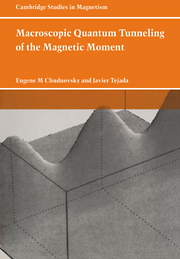Book contents
- Frontmatter
- Contents
- Preface
- Chapter I Introduction
- Chapter 2 Tunneling on a macroscopic scale
- Chapter 3 Magnetism in imaginary time
- Chapter 4 Magnetic tunneling in bulk materials
- Chapter 5 Quantum magnetic relaxation
- Chapter 6 Other experimental approaches
- Chapter 7 Tunneling in magnetic molecules
- References
- Index
Chapter 7 - Tunneling in magnetic molecules
Published online by Cambridge University Press: 16 October 2009
- Frontmatter
- Contents
- Preface
- Chapter I Introduction
- Chapter 2 Tunneling on a macroscopic scale
- Chapter 3 Magnetism in imaginary time
- Chapter 4 Magnetic tunneling in bulk materials
- Chapter 5 Quantum magnetic relaxation
- Chapter 6 Other experimental approaches
- Chapter 7 Tunneling in magnetic molecules
- References
- Index
Summary
Magnetic molecules represent another interesting area for MQT studies. In this chapter we will describe experiments on spin tunneling in macroscopic crystals of Mn12Ac molecules. A Mn12Ac molecule has spin 10 and is equivalent to a very small single-domain magnetic particle. A crystal consists of a macroscopic number of molecules arranged in a tetragonal lattice. Spins of the molecules interact weakly with each other and are subject to a very strong uniaxial anisotropy. A Mn12Ac crystal is, therefore, equivalent to a large system of identical uniformly oriented magnetic particles, which has been wanted so much by experimentalists. Experiments on Mn12Ac [16] are the first experiments on spin tunneling which have been understood quantitatively without any free parameters. Whether the moment of the molecule, 20μB, is macroscopic enough to allow one to talk about MQT is left to the judgement of the reader.
The Mn-12 acetate complex
The chemical formula of the manganese acetate complex discussed below is [Mn12O12(CH3COO)16(H2O)4]·2CH3COOH·4H2O. We will denote it by Mn12Ac. This compound was first synthesized by Liz and characterized by Xray diffraction methods [128]. It forms a molecular crystal of tetragonal symmetry with the lattice parameters a = 1.732 nm and b = 1.239 nm. The unit cell contains two Mn12O12 molecules surrounded by four water molecules and two acetic acid molecules. The structure of the Mn12O12 molecule is shown in Fig. 7.1. The molecule possesses S4 symmetry.
- Type
- Chapter
- Information
- Macroscopic Quantum Tunneling of the Magnetic Moment , pp. 146 - 166Publisher: Cambridge University PressPrint publication year: 1998



